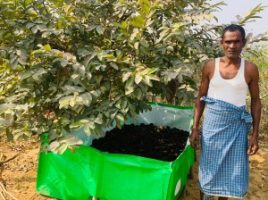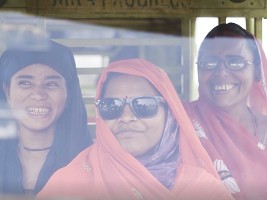Sustainable and Resilient Human Settlements – People and Nature at the Centre of the Transformation We Need

The World Habitat Day is celebrated on the first Monday of October every year. This year, the day coincides with the birthday of Mohandas Karamchand Gandhi, Father of our Nation, and Mahatma to all of us Indians. What better inspiration to look towards than to Gandhian thought to address the poly- crises of resource stress, pollution, and climate change impacts that human settlements are facing today in their quest to achieve sustainability and resilience.
The Indian human settlement landscape today is in tremendous flux and change. Rapid urbanisation characterised by expanding and over-crowded cities; demographic, economic and spatial transformation of villages with service and manufacturing based economies replacing agriculture and allied activities, changes in land-use from agriculture, pasture and forest lands to industry, institutional, commercial and residential infrastructure; and a nebulous peri-urban landscape at threat from encroachment and pollution. All these regions are moving towards greater inequity (well demonstrated in the covid lockdown), higher resource and carbon intensity, and an increasing distance from nature figuratively and literally. And all these regions are more exposed and vulnerable than ever to the impacts of a changing climate.
No doubt that science and policy are weighing-in with technological solutions for higher resource circularity and carbon neutrality; nature-based solutions to complement grey infrastructure, policy directives and minimum quality standards for universal access to housing, basic amenities, energy and mobility services and public campaigns for sustainable consumption practices. However, the application of policy intent is slow and outcomes of sustainability and resilience at local levels are far from being achieved. To quote Oliver Greenfield, global convenor of the Green Economy Coalition, “We know what needs to be done, the question is how”.
At the one end of the spectrum are data intensive and quantitative tools to support policy and planning that require expertise, skills and investments in institutional capacities and frameworks to enable valuation of ecosystem services, carbon saving, resource circularity and economic growth. These are largely used by researchers and experts to inform national policy development and industry transformation. They are necessary, however their application to enhance sustainability and resilience of human settlements is nascent. At the other end of the spectrum are consumption behaviours and perceptions of citizen-actors that determine choices with respect to transport, water, energy, food, fashion and building construction, waste-management etc. In this space, the interventions are largely campaign oriented and often prescriptive with communities as recipients rather than partners of the process of transformative change.
A big gap exists in between these two extremes, in leveraging the potential of citizens – the market or end users or communities, as these are variously called, to drive change as active stakeholders. The interventions to build capacities of citizen-actors to feedback into the rule and regulation making bodies, participate in the planning of their cities and neighbourhoods and actively engage in management of common services and spaces is inadequately supported by formal institutional mechanisms.
People’s movements all over the world, as also in India, are demanding for a change in the relationship between themselves and their formal governance institutions. They are asking for their diverse voices to be heard, for their traditional knowledge systems to be taken on board in decision making, and for their capabilities to engage in governance to be enhanced. And, as more and more citizens become better informed regarding the implications of economic growth and infrastructure development actions, they demand for more ecologically benign and restorative development solutions.
Therefore, a second question that must be asked is on the role of citizenry across the different social-economic strata in the planning, design and management of human settlements, and how may formal institutions build the capacity and agency of citizen-actors to engage with, influence and direct the process of transformation of their neighbourhoods, towns and cities into sustainable resilient and vibrant places to live and to thrive in.
Many examples of community-led planning, design and management of settlements and infrastructure in the Indian human settlements-scape inspire us. Rural areas such as Odanthurai in Tamil Nadu, Piplantari in Rajasthan, Madore in Madhya Pradesh, Hiware Bazaar in Maharashtra and Mawlynnong in Meghalaya demonstrate collaborations between panchayats and communities to bring in innovative technological, management and governance solutions to address food, energy, water and waste management, forest and pasture-land rejuvenation and eco-friendly construction. We see the possibilities of community-led rural to urban transformation in the small town of Magarpatta city near Pune choosing to co-develop a sustainably planned and co-owned urban settlement rather than be engulfed by Pune city. We also find examples of neighbourhood or urban-district transformation from metropolises such as Bangalore where communities are coming together to manage urban wetlands and Gurugram, where communities are leading forest rejuvenation and waste management. These transformative shifts are driven bottom-up, supported with social-ecological and technological knowledge and expertise, demonstrate a shared understanding of implications of both non-action and of mal-development, are linked with local governance processes and are most often resourced by either CSR or non-government funding.
These interventions indicate localised decentralised and largely self-managed, ecologically and socially responsible development reflecting Gandhian principles active engagement and participation of communities in the management of their human settlements (swaraj); built on the understanding of the interconnectedness of human-habitations with nature (advaita) and therefore choose ecologically benign and restorative solutions (trusteeship), reducing wastes, reusing and recycling resources (non-violence towards society and environment). In some of these examples, we see the inclusion and betterment of all members of the community (sarvodaya) and a focus on the most vulnerable ensuring equitable access to habitat goods and services to all (anthodaya).
And, while these bottom-up interventions are often discussed in policy design and development fora, the mechanisms to integrate their lessons in municipal and panchayat planning frameworks and guidelines are missing. Policy makers often critique the relevance of decentralised, people and nature centric process-based approaches to address the complex, large-scale and fast paced urbanisation challenges today. One would argue, however, that the simplicity and human-nature connectedness inspired by Gandhian thought and practice will enable us to navigate the complexity to transform our human settlements to humane, sustainable, and resilient places. Mainstreaming the integration of lessons from community-led processes would be the answer in a large part to the first question “how”?
The views expressed in the article are those of the authors and not necessarily those of Development Alternatives.
This blog first appeared as an editorial in Development Alternatives Newsletter September, 2023 https://devalt.org/newsletter/32






Leave a Reply